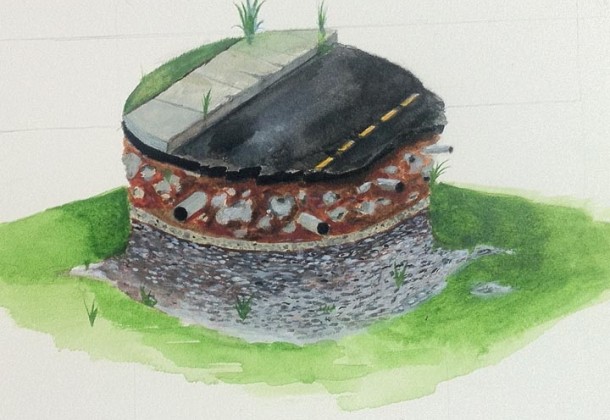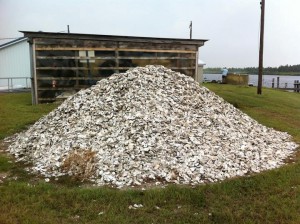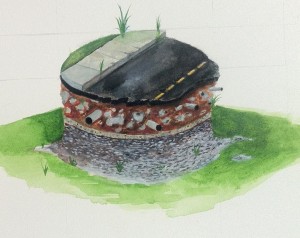‘Hidden Midden’ is a Tribute to Oystering History

Posted by Annmarie Garden
Community Builder
SOLOMONS, MARYLAND – Annmarie Sculpture Garden & Arts Center (Annmarie Garden) fall artist in residence, Kaitlin Pomerantz, will be undertaking the project, Hidden Midden,a sculptural tribute to the history of oystering. Hidden Midden will explore the way that industrialization has affected marine ecosystems during the 20th century and the cultural and environmental implications. It takes its cues from the historical phenomenon of oyster ‘middens’, which are enormous ancient piles of shell formed by Native Americans that once lined the eastern seaboard.
Pomerantz (born 1986, New York City) works primarily in painting and printmaking, exploring different phenomena in nature and in the history of the interaction between humans and the earth. Normally based in Philadelphia, Pomertantz will be with Annmarie Garden until the end of October. Hidden Midden will be the first large scale sculpture project that Pomerantz has commissioned. Pomerantz will begin building the sculpture, with the assistance of artist John Heron, once oyster shells are collected. The public is welcome to observe the construction of the Hidden Midden and create a mini-midden in the artLAB from 1 – 4 p.m. daily.
Request for oyster shells
A significant part of Pomerantz’s construction will require oyster shells and the public is welcome to donate oyster shells to Annmarie Garden. Oyster shell donations can be dropped off at Annmarie Garden (please look for the oyster pile, which is located southwest of the Tonger). Alternatively, Pomerantz will happily retrieve oyster shells from willing donors. Please contact Kaitlin Pomerantz via email at: [email protected] for additional information or call Annmarie Garden, 410-326-4640.
Community Activity at Annmarie Garden
In conjunction with Pomerantz’s Hidden Midden project, the artLAB is raising awareness by hosting the Fall Public Art Project, Mini-Middens, small window hangings that utilize oyster shells, soils, and more to create a beautiful piece of eco-art to take home and display. The Mini-Middens will contain a native plant seed that will sprout (with a little love). Visitors can make a Mini-Midden fromOctober 1through October 19, 2012. Pomerantz will be in the artLAB on Sunday afternoons, through October, 1:00 pm – 4:00 pm.
Project Background: History of Middens on the Eastern Seaboard
From Maine down through Virginia, the eastern seaboard is strewn with ancient piles of oyster shells called middens, which, at their most mammoth, can measure up to miles wide and many feet deep. These colossal heaps consist of discarded oyster shells and other kitchen scraps – like enormous compost piles that contain the food waste of entire Native
 American, pre-colonial, villages. These curious and beautiful sites are of great interest to archeologists, as they provide a window to the past…revealing information about the societies who formed them, as well as the oyster populations whose shells they contain.
American, pre-colonial, villages. These curious and beautiful sites are of great interest to archeologists, as they provide a window to the past…revealing information about the societies who formed them, as well as the oyster populations whose shells they contain.
Once abundant, now only smatterings of oyster middens exist. The disappearance of oyster middens can be attributed to the demand for their rich lime and calcium content, many of which were converted into chicken feed and agricultural enhancers. However, the more devastating force to these middens was the use of oyster shells in road construction, when thousands of tons of shells were hauled and used as road-fill to support the then new asphalt stretches.
Middens are not only anthropological records, but serve as mineral and material repositories for the formation of new oyster habitat. The natural decomposition of oyster shell that occurs during the erosion of coastal middens releases into the water column minerals and nutrients necessary for living oysters to build new shells. The presence of abundant oyster shells along the coastline also provides habitat for oysters to set on— that is, empty shell in the water serves as a landing place for larval oysters to attach to and grow. In the face of a decreased presence of available shell for oysters to grow onto, ocean-acidification, lack of neutral minerals, in addition to extreme industrial over harvesting and pollution; native oyster populations, along the eastern seaboard, have dwindled or disappeared entirely.
The Importance of Oysters
Luckily, oyster restoration projects are underway, many with great success. Unlike the cultivation of fin fish or crustaceans, cultivating shellfish has only positive environmental consequences; the benefits of its living and feeding are increased habitat for other aquatic life and cleaner water. One of the major efforts being made by oyster restoration and aquaculture programs today is to restore shell reefs to provide oysters with suitable habitat and necessary nutrients for growth and viable shell formation. Often shells are mixed with concrete to create chunky slabs and deposited into estuaries to encourage new reef formation. A number of shell recycling programs have popped up throughout the nation to collect discarded shells from restaurants, sterilize them and return them to the water where they can be of use.
Moving Forward
If a better understanding of how oyster shells contribute to healthy oyster populations is gained, an increased effort to return shells to the water and to preserve remaining middens, as sites of historical and ecological importance, may occur. For these reasons, it is important to educate the public about the history of oyster ecology and the role of oyster shell in healthy marine ecosystems. Hidden Midden seeks to bring attention to the history of the midden, raise awareness about the role of shell in rebuilding healthy marine ecosystems, and to highlight the importance of oysters in the cultural and natural history of the Chesapeake.






















